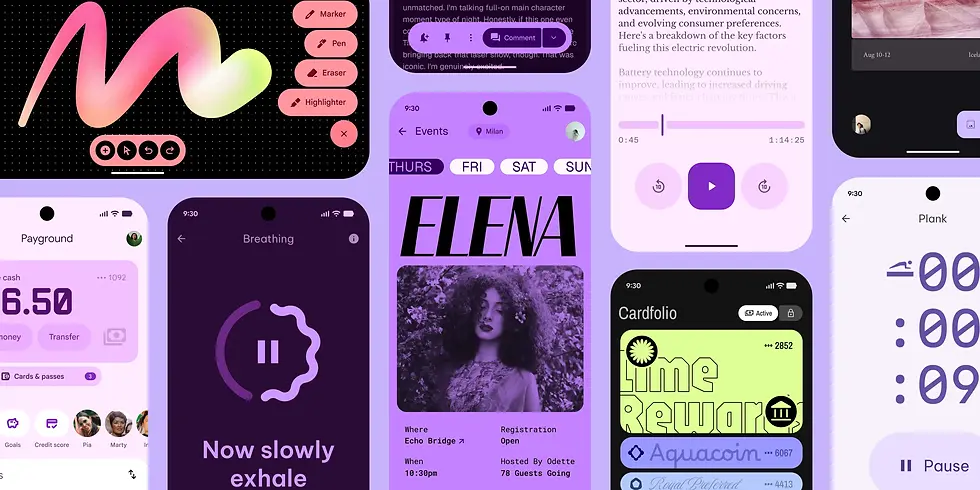Expressive Design: from the system to the soul of the brand.
- Antonio Horcajo Nicolau

- Aug 1
- 4 min read
Can a design system be emotional?
Google, with its latest research on Expressive Material Design , answers with a resounding yes. But it does so from an unusual place: not from a technical perspective, but from empathy, culture, and the urgent need for brands to recover something they are losing: their ability to connect emotionally in an increasingly algorithmic environment.

Expressive design charts a path from the system to the soul of the brand. The paradox of coherence
Material Design was born in 2014 with the mission of unifying the visual experience of Google's products. Its structure, based on physical principles (such as the metaphor of paper and light), was revolutionary at the time. But over time, as with many systems, an inevitable tension emerged: excessive consistency can erode differentiation .
This isn't new. Since the thinking of Marty Neumeier and David Aaker, we know that brands don't just need to be consistent: they need to be recognizable, memorable, and emotionally relevant . And that's not always achieved with an overly rigid design system.
We must move towards living and expressive systems
Google's research, developed with creative studios around the world, proposes an evolutionary framework: maintaining the structure and functionality of Material Design, but infusing it with systemic expressiveness . How? Through three key principles:
1. Emotional intentionality
Design not only for functionality, but to provoke specific emotions: security, joy, surprise, or belonging.
2. Variety within the system
Allow products to breathe their own identity within the system. As Branzai says, “The brand is everything; the system is the tool. They should not be confused.”
3. Narrative cohesion
Expressiveness must be part of brand storytelling. As Comuniza argues, "a brand must excite with every pixel, because every pixel communicates."
This approach is not just an aesthetic improvement: it is a strategic shift that places the person (and their emotional and cultural context) at the center of the system.
A New Zeitgeist: From Flat to Expressive
Google's proposed redesign is aligned with many other cultural and market signals. Some examples that reinforce this paradigm shift:
Adobe Creative Trends 2025 highlights the “Fantastic Frontiers” trend, where brands are looking for new, more dreamlike, emotive, and symbolic visual languages to stand out in a saturated and predictable environment.
Accenture Life Trends 2025 warns of digital burnout and the “impatience economy,” where users value experiences that bring clarity, beauty, and meaning.
Contagious 2024 shows how brands like Specsavers, Coca-Cola, and McDonald's have revived storytelling, humor, and emotion as key drivers of cultural connection.
The conclusion is clear: brands that don't excite don't compete . And a design system that doesn't allow for emotion is a liability.
Key principles of M3 Expressive that resonate with our approach:
To make it easier to understand, I have prepared this table in which I try to connect proposal and approach:
Dimension | What M3E proposes | How to boost your branding system |
Color | Dynamic and bold tones, semantic roles | Evokes moods: calm, action, confidence |
Typography | Expanded typographic scale and use of variable fonts | Define hierarchy, personality and intention () |
Forms | 35 new geometries and shape morphing | Add character and visual uniqueness () |
Components | Button groups, split buttons, FAB menus, loading waveforms… | They enhance usability and expressiveness () |
Movements | Physics-based system (springs, easing, delays) | They guide the user and convey emotional tone () |
Accessibility | Contrast, reading, optimized interactions | Inclusive design, with emotion but with clarity () |
Beyond visual design: the system as a cultural reflection.
Expressiveness shouldn't be limited to the interface. At identty, we understand that the design system should be a synthesis of the brand's personality . It should include not only the graphic components, but also the tone, interaction, animation, and narrative. In short, it should translate the brand's DNA into a living and meaningful experience.
In an environment where brands coexist with generative artificial intelligence, content automation, and platforms that dictate the rules, the only way to avoid being replaceable is to be irreplaceable . And that can only be achieved with soul.
From design that works to design that vibrates
Google has opened a bold new door: that of expressive systems. It's an invitation for brands to reclaim their voice in an increasingly homogeneous environment. It's a reminder that expression is not the opposite of structure, but its most sophisticated evolution .
As Paul Rand said, “Design is the silent ambassador of your brand.” But today more than ever, that ambassador needs to have something to say, and know how to say it.
Expressive design isn't a fad; it's a necessity. And this Google study is a roadmap for starting to move toward more human, emotional, and relevant systems.
Brands that understand this and dare to play by their own visual rules will be the ones that make the difference in a world saturated with undifferentiated interfaces.
And you? Do you think following the same path as the rest is what you should do? If not, write to us, call us, or visit us, and we'll be happy to help you chart the path to success for your brand.




Comments